26-Year-Old Emergency Medical Technician Dies in Multiple Fatality Ambulance Crash - Kentucky
NIOSH In-house FACE Report 2001-11
Summary
On May 15, 2001, a 26-year-old emergency medical technician (the victim) died when the ambulance she was working in was struck head-on by a motorist. The emergency medical technician (EMT) had been riding unrestrained in the ambulance patient compartment while attending an elderly patient during a non emergency medical transport. As the ambulance was traveling along a two-lane rural highway at about 55 miles per hour (mph) a motorist operating a pickup truck left of the centerline in excess of 70 mph approached the ambulance head-on. The paramedic driving the ambulance attempted to avoid collision by turning left-of-center; however, the motorist’s pickup struck the right side front quarter of the ambulance. During the collision, the EMT struck the front bulkhead of the patient compartment. The paramedic had been driving unrestrained and suffered severe injury. The motorist and elderly patient also suffered fatal injuries. The EMT and paramedic were airlifted to a local trauma center. The EMT died en route of blunt force trauma to the head and chest. The paramedic suffered multiple serious injuries including a broken leg and recovered after a stay in the hospital.
NIOSH investigators concluded that, to help prevent similar occurrences, employers should
- ensure that emergency service workers use the patient compartment vehicle occupant restraints whenever possible
- consider equipping ambulances with patient cots that include upper body restraints, and
- ensure that drivers and front-seat passengers of emergency service vehicles use the vehicle occupant restraints provided
Ambulance manufacturers and emergency medical services should
- evaluate and develop occupant protection systems designed to increase the crash survivability of EMS workers in ambulance patient compartments
Introduction
On May 15, 2001, a 26-year-old EMT died when the ambulance she was working in was struck head-on by a motorist. On May 16, 2001, the Division of Safety Research (DSR) learned of the incident from a Kentucky State Police Trooper. On June 4, 2001, a Safety and Health Specialist and a Safety Engineer met with the State Police investigators and discussed the case. On June 5, 2001, the Safety and Health Specialist and the Safety Engineer interviewed the ambulance service owner, examined and photographed the ambulance, and visited the incident site. The employer was an independent ambulance service in business for 17 years. The service had 24 employees, and the ambulance fleet included 6 Type II and 3 Type I ambulances*. The employer had written policies and standard operating procedures that included a mission statement, rules and guidelines for ambulance drivers, and daily vehicle maintenance checks. The company employed a full-time maintenance mechanic. Company policy required that members of patients’ families use seat belts when riding as ambulance passengers. Seat belt use by employees was not addressed in the company policy except that when driving, employees were expected to comply with state motor-vehicle laws. Kentucky requires the use of seat belts when operating a motor vehicle.
The paramedic had been driving for the company for 9 years. He had a valid state driver’s license and had completed a defensive driving course. The EMT had 6 years’ experience with the company.
This was the second fatal incident for the company. A similar incident involving a head-on collision with a coal truck had occurred in 1992 and resulted in four fatalities, two of whom were employees of the ambulance service.
* A Type I ambulance consists of a conventional truck cab-chassis on which a modular ambulance body, the patient compartment, is mounted.
Back to Top
Investigation
The 1991 Type I ambulance involved in this incident was previously owned and had been purchased by the ambulance service in 1999. The ambulance had a gross vehicle weight rating (GVWR) of 12,450 lbs.
On the day of the incident, the ambulance crew, a paramedic and an EMT (the victim), had been assigned to transport an 83-year-old nursing home resident to a regional medical center, a drive of about 1½ hours. The crew arrived at the nursing home at 5:45 a.m. The patient was placed on the patient cot, secured by lap-belt type restraints across her body just below the pelvis and her legs.
The cot was loaded onto the ambulance and secured in place by a floor-mounted latch system. The paramedic was driving unrestrained as the ambulance left the small town and accessed a two-lane parkway, speed limit 55 mph. The EMT was seated unrestrained on the left-facing squad bench while attending the patient. At about 6:15 a.m., the crew was traveling westward along a straight section of the parkway when the paramedic observed a motorist traveling left-of-center and approaching at a high rate of speed. The paramedic attempted to evade the motorist by also turning left-of-center but was unsuccessful, and the motorist struck the ambulance in the right front quarter. The ambulance continued to travel toward the eastbound shoulder before coming to a stop against the guardrail. The collision impact spun the motorist’s pickup around almost 360 degrees before it also came to rest. During the collision, the EMT continued moving forward and struck the front bulkhead (Photo 2). The patient was ejected from the cot restraints and also struck the front bulkhead of the patient compartment, coming to rest head-down on top of the EMT.
State police, a local fire department, and the county ambulance service responded to the incident. The patient and motorist were pronounced dead at the scene. The EMT was airlifted to a regional trauma center but died en route. The paramedic survived the incident but suffered serious multiple injuries including a broken leg.
Back to Top
Cause of Death
The coroner established the cause of death for the EMT as blunt trauma to the head and chest.
Recommendations/Discussion
Recommendation #1: Employers should ensure that emergency service workers use the patient compartment vehicle occupant restraints whenever possible.
Discussion: The patient compartment of the ambulance involved in this incident was configured with four seating positions, each equipped with two-point lap-belt restraints. These positions included a rear-facing, high-backed captain’s chair and a squad bench with accommodation for three persons (Photo 3). The employer’s written policies contained procedures for transporting family members or other appropriate passengers that required them to ride restrained at the head of the cot in the captain’s seat. However, the program did not address restraint use by EMTs working in the patient compartment. Reportedly, the victim’s normal routine was to occupy the squad bench while working in the patient compartment. In this position, she had good access to the patient and the patient could see her. Elderly patients often become anxious if they cannot see the attendant. It should be noted that the lap-belt restraint systems commonly used in ambulances do not allow full access to the patient during treatment for all conditions. When properly used, the squad bench lap belts position the occupant against the side wall in such a manner that the EMT cannot bend forward to access the patient. If the EMT needs to access the cabinets along the street-side wall, the belts must be unbuckled to allow the EMT to stand up. Additionally, if it is necessary to perform CPR or other procedures such as intubation or insertion of IVs, the EMT may need to stand over or kneel near the cot. For these reasons, it may be common practice among EMTs to ride unrestrained, seated on the edge of the squad bench. However, during non emergency transport, EMTs could remain seated and restrained in the captain’s chair or, alternatively, the EMT could be seated restrained on the squad bench. Because force magnitude estimates for this crash were not available, the degree of protection for the victim had restraints been used could not be evaluated. Had restraints been used, the EMT would most likely have been held in place on the squad bench and not have impacted against the front bulkhead during the collision. Her injuries may have been minimized. The ambulance cab was severely damaged during the collision; however, the patient compartment suffered very little damage (Photos 4 and 5). Had the victim been seated and restrained in the rear-facing captain’s seat, her injuries may have been less severe.
Recommendation #2: Employers should consider equipping ambulances with patient cots that include upper-body restraints.
Discussion: During the collision, the patient was ejected from the cot and came to rest head-down on top of the EMT after striking the front bulkhead. The cot involved in the incident was equipped with lap-belt type restraints located to cross the patient just below the pelvis and across the legs. Cot manufacturers currently make available cots equipped with four-point restraints for the patient’s upper body in addition to the two lower-body restraints (Photo 6). Employers and operators of ambulance services should consider equipping their ambulance fleets with this type of cot. As evidenced by this incident, belt restraints across the patient’s body offer little or no resistance to forward movement induced from frontal collision. Had the patient been restrained with shoulder belts, her injuries may have been minimized. Additionally, it should be noted that during a crash, secondary collisions between unrestrained occupants in the patient compartment may also be a source of significant injury.
Recommendation #3: Employers should ensure that drivers and front-seat passengers of emergency service vehicles use the vehicle occupant restraints provided.
Discussion: The ambulance involved in this incident was equipped with lap-belt restraints for the driver and front-seat passenger. At the time of the collision, the paramedic was driving unrestrained. Although the paramedic recovered from his injuries, they may have been minimized if the occupant restraints had been used. Studies have shown that for light-truck occupants, the use of restraints reduces the risk of fatal injury by 60% and the risk of moderate-to-critical injury by 65%.1
Recommendation #4: Ambulance manufacturers and emergency medical services should evaluate and develop occupant protection systems designed to increase the crash survivability of EMS workers in ambulance patient compartments.
Discussion: Currently, ambulance patient compartments are equipped with two-point lap-belt-type occupant restraints. As previously noted, proper use of these restraints precludes EMS worker mobility in the patient compartment and access to the patient for procedures such as CPR. Harness-type restraint systems which afford user mobility are commonly used in military aircraft and civilian air ambulances. Similar systems have been designed for ground ambulances and are being used on a limited scale.2 These systems employ retractor-equipped tethers connected between a user-worn harness and strategic locations on the vehicle structure. The retractors provide occupant mobility by allowing the tether to pay out from a reel. The retractor automatically locks the reel at predetermined acceleration levels to limit occupant motion during a crash. The ground vehicle crash performance and user acceptability of these systems has not been fully evaluated. However, they appear to have potential for improving the crash survivability of workers in ambulance compartments.
Back to Top
References
- NHTSA Traffic Safety Facts 2000, DOT HS 809 327. Washington, D.C. : U.S. Department of Transportation, National Highway Traffic Administration, National Center for Statistics and Analysis, Research and Development.
- Spivak M. [1998] Buckle up! Kicker Vest Attendant Restraint System protects providers. Emergency Medical Services. 27(11):47-49.
Investigator Information
This investigation was conducted by Paul H. Moore, Safety Engineer, Fatality Assessment and Control Evaluation Team, and Nancy T. Romano, Safety and Occupational Health Specialist, Fire Fighter Fatality Investigative and Prevention Team, Surveillance and Field Investigations Branch, Division of Safety Research, NIOSH.
Photographs
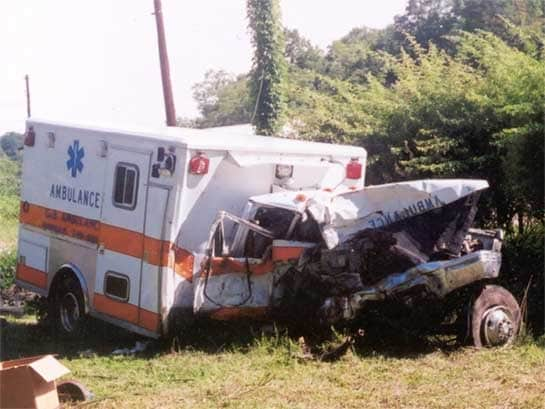
|
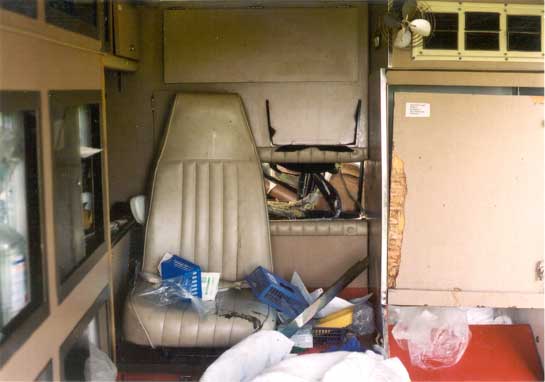
|
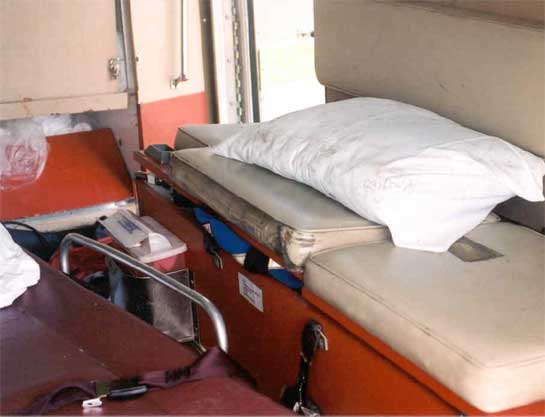
|
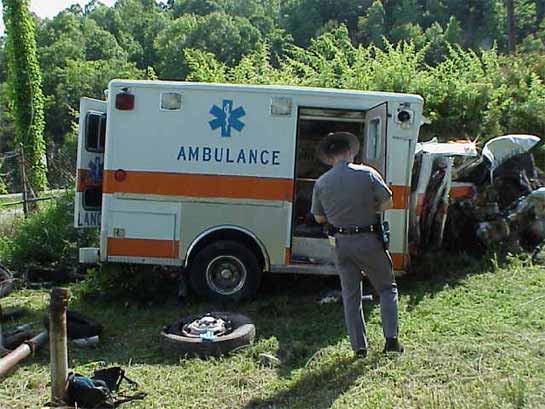
|
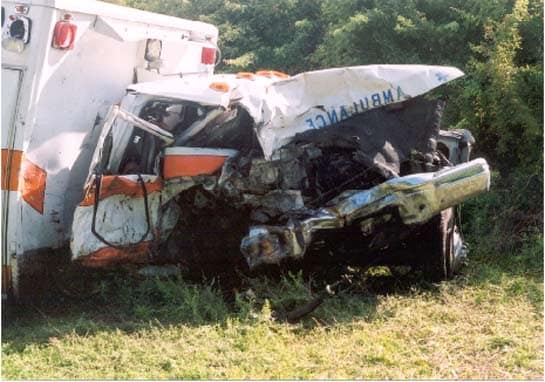
|
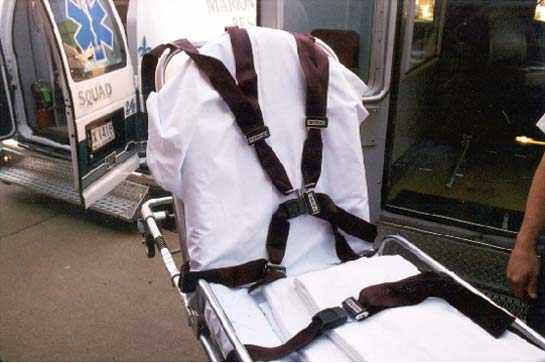
|
|
Photo 6. Patient cot equipped with four-point upper-body restraint.
|
In-house Reports
